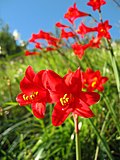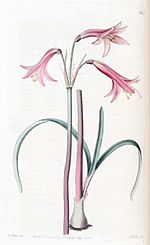Phycella is a genus of herbaceous, perennial bulbous flowering plants belonging to the family Amaryllidaceae, subfamily Amaryllidoideae. The genus consists...
9 KB (737 words) - 23:09, 30 July 2024
Phycella cyrtanthoides, the Añañuca de Fuego, is a species of flowering plant in the family Amaryllidaceae. It is a bulbous geophyte endemic to central...
2 KB (120 words) - 11:28, 26 December 2023
Phycella chilensis is a species of flowering plant in the family Amaryllidaceae. It is a bulbous geophyte endemic to central Chile. "Phycella chilensis"...
1 KB (54 words) - 03:43, 22 December 2023
IAU new 2022 Chilean proposal; named for the endemic Chilean wildflowers Phycella cyrtanthoides. /aɲaˈɲuka/ Aquarius θ Aquarii Ancha /ˈæŋkə/ Eridanus τ2...
103 KB (2,126 words) - 16:22, 3 May 2024
- Phycella cyrtanthoides Eustephia cyrtanthoides - Phycella cyrtanthoides Eustephia herbertiana - Phycella herbertiana Eustephia ignea - Phycella cyrtanthoides...
3 KB (253 words) - 20:14, 2 December 2023
with equitant sepals, and flat, spongy seeds" and included Amaryllis, Phycella, Nerine, Vallota, and Calostemma. By 1846, in his final scheme Lindley...
68 KB (6,233 words) - 12:47, 22 June 2024
subgenera, namely (number of species in parentheses) Habranthus (10), Phycella (3), Rhodophiala (5), Macropododastrum (1), Omphalissa (6), Aschamia (10)...
87 KB (7,996 words) - 18:02, 9 August 2024
Phaedranassa Herb. (syns Neostricklandia Rauschert, Stricklandia Baker) Phycella Lyndl. (including Famatina Ravenna, Placea Miers) Plagiolirion Baker Proiphys...
7 KB (346 words) - 05:25, 4 November 2022
morphologically similar to other species of its genus, but also notably to Phycella cyrtanthoides. Z. phycelloides, however, has a trifid (three lobed) stigma...
2 KB (123 words) - 07:13, 1 November 2023
segregated with Phycella and was consequently transferred: The generic distribution here is based on Garcia et al 2019. [Placea previous genus] Phycella (~13 species)...
6 KB (538 words) - 20:07, 17 March 2024
Herbert = Zephyranthes Placea Miers = Phycella Rhodolirium Philippi = Phycella Rhodophiala C. Presl = Phycella Sprekelia Heister = Zephyranthes Tocantina...
20 KB (1,621 words) - 20:28, 14 July 2024
of subtribe Hippeastrinae. The first species is now placed in the genus Phycella, the others in the genus Zephyranthes. Described species: Famatina andina...
5 KB (345 words) - 19:42, 13 March 2023
planet is named Tahay, after names for the endemic Chilean wildflowers Phycella cyrtanthoides and Calydorea xiphioides. The star Gliese 367 was observed...
12 KB (1,026 words) - 23:01, 17 July 2024
This genus does not have any accepted species, since it is a synonym of Phycella Lindl. Former species include: Rhodophiala advena (Ker Gawl.) Traub – Central...
7 KB (553 words) - 23:02, 20 April 2023
after names for the endemic Chilean wildflowers Calydorea xiphioides and Phycella cyrtanthoides. Calydorea xiphioides only blooms for between 7 and 8 hours...
9 KB (679 words) - 16:50, 7 June 2024
species of Famatina were polyphyletic and F. maulensis segregated with Phycella and was consequently placed in Traubiinae, while the remaining three segregated...
9 KB (837 words) - 00:59, 21 June 2024
perianthium with equitant sepals, and flat spongy seeds" and included Amaryllis, Phycella, Nerine, Vallota, and Calostemma. By 1846 Lindley had greatly expanded...
45 KB (3,900 words) - 02:46, 8 April 2024
indeed polyphyletic with three species segregating as a sister group to Phycella which they proposed to resurrect as genus Rhodolirium, while the remainder...
10 KB (840 words) - 02:16, 30 July 2024
Hippeastreae) and did not recognise Worsleya, which they submerged in Phycella. In contrast, Meerow and Snijman (1998) resurrected it, placing both genera...
8 KB (595 words) - 03:32, 25 June 2024














